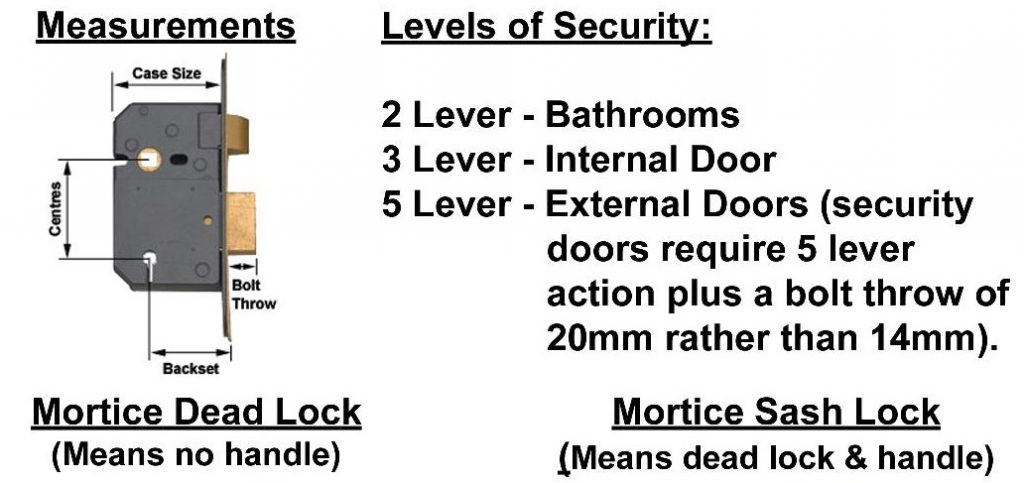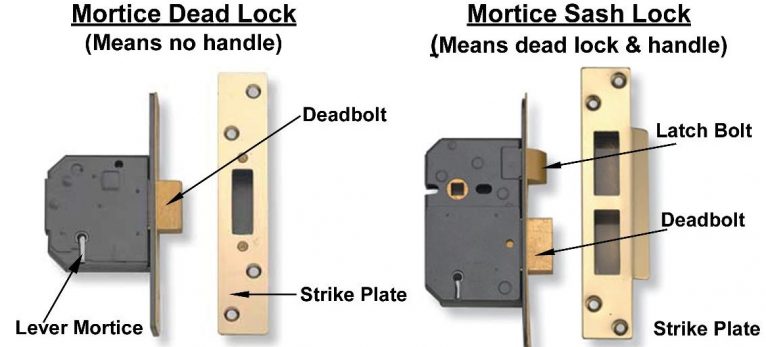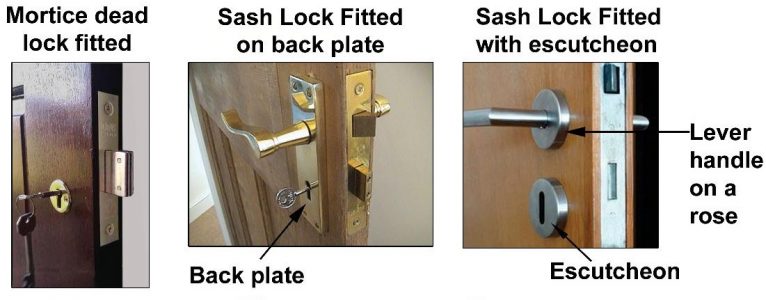What is a Mortice Lock?

If you are considering which type of lock would be most suitable to help secure your property, you may find yourself asking what is a mortice lock?. In short, a mortice lock is a commonly used design in which the lock sits within a wooden door, as opposed to other designs which are mounted upon doors. The advantage of mortice locks sitting within doors is that it makes it extremely difficult for intruders to force open.
Mortice locks also have an incredible reputation for being one of the most difficult lock designs to pick, as the design incorporates a larger amount of levers (especially in the higher end models). As you would expect with a lock with this level of security, mortice locks comply with the requirements of insurance policies for use on property entrance doors.
How does a Mortice Lock work?
As we mentioned above, one of the main features of a mortice lock is how it sits within as opposed to mounted on a door. Due to the size and positioning of mortice locks, you will require a wooden door with a good thickness in order to accommodate a mortice lock.
When it comes to the inner mechanism of a mortice lock there are three key working components which include the bolt, parallel levers and the bolt-stop. To put it simply, when the correct key is placed within a mortice lock, the shape will naturally meet the number of parallel levers causing them all to align. Once the key is rotated, this will cause the bolt to withdraw into the free space within the mortice lock and the door to become unlocked.
Due to the correct key being uniquely cut to the multiple parallel levers if the incorrect key is used it will simply not be able to fit (fully enter) the lock or upon rotation it will not catch and align the levers in the right way and the bolt won’t be retracted.
What are the other parts of a Mortice Lock?

Now that we know how the inside of a notice lock mechanism works, we can look at the external parts of a mortice lock and what the role they play. The most obvious and recognisable way of identifying a mortise lock is the face plate. In most designs this is an individual piece of metal that is added and faces directly against the strike plate. The strike plate is the separate part of the mortice lock which fits into the door frame. The face plate and strike plate both work together in order to ensure that neither the dead bolt or latch bolt come into contact and scuff or damage the wooden door or door frame.
One final part of a mortice lock which is usually added only for design purposes is the option of escutcheon plates. These simply are only for aesthetic purposes and are rectangle metal plates surrounding the lock and door handle or cylinder plates only surrounding the lock.
What are the different types of Mortice Locks?

It is true that you will most commonly find mortice locks on external doors. However, there are a range of different types of mortice locks that are also suitable to indoor use. To try and keep this simple, we will firstly explain the different levels of mortice lock and where they are best suited, followed by different types of mechanism.
The way in which mortice locks are ranked in terms of security is by how many parallel levers they have included within its mechanism. The more levers included within the lock mechanism, the more secure the lock is. This is because the key is uniquely cut in order to fit and align all of the levers within the lock mechanism which causes the retraction of the bolt and unlocking.
The most commonly used mortice lock for indoor use are locks with 2 or 3 levers and this is because the relatively low level of security needed to lock for example an internal bathroom. The more secure mortice locks with 5 or 7 levers are locks for external doors. There are many security reasons for this including the increased level of security against intruders. However, when it comes down to regulations, most insurers will only provide policies to properties using external mortice locks with a minimum of 5 levers.
Finally, you will also need to know about the differences between a mortice deadlock or a mortice sashlock. There are other mortice lock designs available; however, these are the most common and our preference at Wonkee Donkee.
The way in which deadlocks and sashlocks differ is the operating mechanism. Deadlocks are the most simple types of lock on the market. They operate only by a bolt that goes back and forth which is attached to a spring. This means that the only way to open the door is to have the key in the lock and rotated until the lock is released. As soon as the key is removed, the lock will automatically spring back out and when the door closes it will again be locked.
Alternatively, sashlocks operate differently. Mortice sashlocks will also feature a latch mechanism that includes a handle. This is much more commonly used and simply means the door can be unlocked and the handle used to operate it to open and close, before at the end of the evening or when leaving a property the lock can be activated again by turning the key in the opposing direction.
How secure are Mortice Locks?
There are many reasons why mortice locks are so popular, mainly the security and reliability of their operating mechanism. However, as we discussed in the earlier section there are different levels to the security of mortice locks which comes from the number of parallel levers within the mechanism. The reason this makes it more secure is that the more levers there are, the more difficult it is to pick and thus more secure. Locks with 5 or 7 levers are much more suited to external doors where intruders are most likely going to be trying to gain access, whereas mortise locks with a lower number of levers are more suited to internal doors where locking is simply for privacy (e.g. bedrooms or bathrooms). As you’d expect the more levers within a mortise lock, the more expensive it is, hence why lower grade locks are used for internal use.
Another important factor to consider when considering the security of mortise locks is the compliance with regulations. If you are unaware, for insurance policies to be taken out and be valid upon break-ins, your external entrances must have locks of a certain security standard. In the UK, the BS3621 standard is what a lock must adhere to or be more secure than. This legislation simply means that the lock in question is strong enough so that it cannot be dismantled from the exterior of the property – well more specifically, the lock should be able to withstand 5 minutes when tested with a drill and the bolt should need to penetrate 2cm into the mortice. The easiest way to make sure that your lock is up to scratch is to check for the British Standard kitemark. This is a sign of quality and adherence to the BS3621 standard or higher.
Can you make Mortise Locks more secure?
As with any lock mechanism you can always combine it with other security systems in order to increase safety. Across the UK, many police forces have recommended combining double-locking night latches with mortice locks in order to provide reinforcement when it comes to security. This advice is mainly for external doors which intruders would most likely be targeting. Examples of areas most prone to break-ins are any external doors that are hidden from public street view, in homes this tends to be to the rear of the property. So make sure you have sufficient lock security in order to protect your property.






